Phase Field Study of the Microstructural Dynamic Evolution and Mechanical Response of NiTi Shape Memory Alloy under Mechanical Loading
Abstract
1. Introduction
2. Phase Field Model
2.1. Phase Field Equation
2.2. Local Free Energy
2.3. Mechanical Equilibrium Equation and Boundary Condition
2.4. Model Parameters
3. Results and Discussion
3.1. The Microstructural Evolution of NiTi Single Crystal under a Fixed Temperature
3.2. Microstructure and Mechanical Response Dependent on the SME
3.3. Microstructure and Mechanical Response Dependent on the Superelasticity
4. Conclusions
- (1)
- In the transition from the cubic B2 phase to the monoclinic B19′ phase with six martensite variants, the poly-twinned martensitic microstructure is formed by self-accommodating nucleation and growth. The evolution of the B19′ multivariants with different free-stress transformation strain causes the local deformation, resulting in the shape of the simulation area changing slightly.
- (2)
- In the numerical simulation of the SME of NiTi SMA, the martensite detwinning takes place at the beginning of loading. The variants expand or vanish depending on the stress-free strain of B19′ multivariants and the direction of applied stress. The detwinning of the twinned martensitic structure finishes in a short time. After the detwinning, the material microstructure remains almost constant until the unloading is finished since the elastic energy of the material is minimal.
- (3)
- The numerical simulation of the superelasticity behavior of the NiTi single crystal SMA accurately reproduces the complex evolution of microstructural morphologies during the martensitic and inverse phase transformation, and obtains the mechanical response of NiTi SMA in the process of loading-unloading.
- (4)
- The results of the tension and compression test show an asymmetry for both the microstructure and mechanical response. The stress-accommodating martensite variants annex the ones of stress-unaccommodating gradually, and, thus, the different loading directions obtain different microstructures, which contain different martensite variants, resulting in various mechanical properties of NiTi SMA.
Author Contributions
Funding
Institutional Review Board Statement
Informed Consent Statement
Data Availability Statement
Acknowledgments
Conflicts of Interest
References
- Chen, L.Q.; Wang, Y. The continuum field approach to modeling microstructural evolution. JOM 1996, 48, 13–18. [Google Scholar] [CrossRef]
- Otsuka, K.; Ren, X. Physical metallurgy of Ti–Ni-based shape memory alloys. Prog. Mater. Sci. 2005, 50, 511–678. [Google Scholar] [CrossRef]
- Ahluwalia, R.; Xue, D.; Saxena, A. Dynamic strain loading of cubic to tetragonal martensites. Acta Mater. 2006, 54, 2109–2120. [Google Scholar] [CrossRef]
- Ahadi, A.; Sun, Q. Stress-induced nanoscale phase transition in superelastic NiTi by in situ X-ray diffraction. Acta Mater. 2015, 90, 272–281. [Google Scholar] [CrossRef]
- Jani, J.M.; Leary, M.; Subic, A.; Gibson, M.A. A review of shape memory alloy research, applications and opportunities. Mater. Des. 2014, 56, 1078–1113. [Google Scholar] [CrossRef]
- Farber, E.; Zhu, J.-N.; Popovich, A.; Popovich, V. A review of NiTi shape memory alloy as a smart material produced by additive manufacturing. Mater. Today Proc. 2020, 30, 761–767. [Google Scholar] [CrossRef]
- Li, H.F.; Qiu, K.J.; Zhou, F.Y.; Li, L.; Zheng, Y. Design and development of novel antibacterial Ti-Ni-Cu shape memory alloys for biomedical application. Sci. Rep. 2016, 6, 37475. [Google Scholar] [CrossRef]
- Choudhary, N.; Kaur, D. Shape memory alloy thin films and heterostructures for MEMS applications: A review. Sens. Actuators A Phys. 2016, 242, 162–181. [Google Scholar] [CrossRef]
- Fang, C.; Zheng, Y.; Chen, J.; Yam, M.C.; Wang, W. Superelastic NiTi SMA cables: Thermal-mechanical behavior, hysteretic modelling and seismic application. Eng. Struct. 2019, 183, 533–549. [Google Scholar] [CrossRef]
- He, Y.; Sun, Q. Rate-dependent domain spacing in a stretched NiTi strip. Int. J. Solids Struct. 2010, 47, 2775–2783. [Google Scholar] [CrossRef]
- Meng, X.; Sun, B.; Sun, J.Y.; Gao, Z.Y.; Cai, W.; Zhao, L.C. Microstructure and Shape Memory Behavior of Ti–Nb Shape Memory Alloy Thin Film. Shape Mem. Superelasticity 2017, 3, 230–237. [Google Scholar] [CrossRef]
- Hane, K.; Shield, T. Microstructure in the cubic to monoclinic transition in titanium–nickel shape memory alloys. Acta Mater. 1999, 47, 2603–2617. [Google Scholar] [CrossRef]
- Waitz, T.; Kazykhanov, V.; Karnthaler, H. Martensitic phase transformations in nanocrystalline NiTi studied by TEM. Acta Mater. 2004, 52, 137–147. [Google Scholar] [CrossRef]
- Biranvand, K.; Vaezi, M.; Razavi, M. Thermodynamic study on the formation of order-disorder structure of the NiAl intermetallic compound by semi-empirical model. Phys. B Condens. Matter 2019, 561, 43–53. [Google Scholar] [CrossRef]
- Lobo, P.S.; Almeida, J.; Guerreiro, L.; Guerreiro, L. Shape Memory Alloys Behaviour: A Review. Procedia Eng. 2015, 114, 776–783. [Google Scholar] [CrossRef]
- Xiong, F.; Yang, H.; Liu, K.; Man, J.; Chen, H. Forming and two-way shape memory effect of NiTi alloy induced by laser shock imprinting. Opt. Laser Technol. 2019, 120, 105762. [Google Scholar] [CrossRef]
- Ng, K.; Sun, Q. Stress-induced phase transformation and detwinning in NiTi polycrystalline shape memory alloy tubes. Mech. Mater. 2006, 38, 41–56. [Google Scholar] [CrossRef]
- Arghavani, J.; Auricchio, F.; Naghdabadi, R.; Reali, A.; Sohrabpour, S. A 3-D phenomenological constitutive model for shape memory alloys under multiaxial loadings. Int. J. Plast. 2010, 26, 976–991. [Google Scholar] [CrossRef]
- Dhala, S.; Mishra, S.; Tewari, A.; Alankar, A. Modeling of finite deformation of pseudoelastic NiTi shape memory alloy considering various inelasticity mechanisms. Int. J. Plast. 2019, 115, 216–237. [Google Scholar] [CrossRef]
- Paranjape, H.M.; Paul, P.P.; Amin-Ahmadi, B.; Sharma, H.K.; Dale, D.; Ko, J.P.; Chumlyakov, Y.I.; Brinson, L.C.; Stebner, A.P. In situ, 3D characterization of the deformation mechanics of a superelastic NiTi shape memory alloy single crystal under multiscale constraint. Acta Mater. 2018, 144, 748–757. [Google Scholar] [CrossRef]
- Provatas, N.; Elder, K. Phase-Field Methods in Material Science and Engineering; Wiley-VCH: Weinheim, Germany, 2010. [Google Scholar] [CrossRef]
- Ke, C.B.; Cao, S.S.; Ma, X.; Zhang, X.P. The Twinning Modes of B2-B19′ Martensitic Transformation in NiTi Alloys—A Phase Field Study. Adv. Mater. Res. 2011, 399, 1768–1772. [Google Scholar] [CrossRef]
- Zhong, Y.; Zhu, T. Phase-field modeling of martensitic microstructure in NiTi shape memory alloys. Acta Mater. 2014, 75, 337–347. [Google Scholar] [CrossRef]
- Levitas, V.I. Phase field approach to martensitic phase transformations with large strains and interface stresses. J. Mech. Phys. Solids 2014, 70, 154–189. [Google Scholar] [CrossRef]
- Esfahani, S.E.; Ghamarian, I.; Levitas, V.; Collins, P.C. Microscale phase field modeling of the martensitic transformation during cyclic loading of NiTi single crystal. Int. J. Solids Struct. 2018, 146, 80–96. [Google Scholar] [CrossRef]
- Chen, L.-Q. Phase-Field Models for Microstructure Evolution. Annu. Rev. Mater. Res. 2002, 32, 113–140. [Google Scholar] [CrossRef]
- Xie, X.; Kang, G.; Kan, Q.; Yu, C.; Peng, Q. Phase field modeling for cyclic phase transition of NiTi shape memory alloy single crystal with super-elasticity. Comput. Mater. Sci. 2018, 143, 212–224. [Google Scholar] [CrossRef]
- Mamivand, M.; Zaeem, M.A.; El Kadiri, H. Shape memory effect and pseudoelasticity behavior in tetragonal zirconia polycrystals: A phase field study. Int. J. Plast. 2014, 60, 71–86. [Google Scholar] [CrossRef]
- Hu, S.; Henager, C.H.; Chen, L. Simulations of stress-induced twinning and de-twinning: A phase field model. Acta Mater. 2010, 58, 6554–6564. [Google Scholar] [CrossRef]
- Mamivand, M.; Zaeem, M.A.; El Kadiri, H.; Chen, L.-Q. Phase field modeling of the tetragonal-to-monoclinic phase transformation in zirconia. Acta Mater. 2013, 61, 5223–5235. [Google Scholar] [CrossRef]
- Levitas, V.I.; Idesman, A.V.; Preston, D.L. Microscale Simulation of Martensitic Microstructure Evolution. Phys. Rev. Lett. 2004, 93, 105701. [Google Scholar] [CrossRef]
- Idesman, A.; Levitas, V.; Preston, D.; Cho, J.-Y. Finite element simulations of martensitic phase transitions and microstructures based on a strain softening model. J. Mech. Phys. Solids 2005, 53, 495–523. [Google Scholar] [CrossRef]
- Li, X.; Su, Y. A phase-field study of the martensitic detwinning in NiTi shape memory alloys under tension or compression. Acta Mech. 2020, 231, 1539–1557. [Google Scholar] [CrossRef]
- Xu, B.; Kang, G.; Kan, Q.; Xie, X.; Yu, C.; Peng, Q. Phase field simulation to one-way shape memory effect of NiTi shape memory alloy single crystal. Comput. Mater. Sci. 2019, 161, 276–292. [Google Scholar] [CrossRef]
- Sun, Y.; Luo, J.; Zhu, J.; Zhou, K. A non-isothermal phase field study of the shape memory effect and pseudoelasticity of polycrystalline shape memory alloys. Comput. Mater. Sci. 2019, 167, 65–76. [Google Scholar] [CrossRef]
- Xu, B.; Kang, G.; Yu, C.; Kan, Q. Phase field simulation on the grain size dependent super-elasticity and shape memory effect of nanocrystalline NiTi shape memory alloys. Int. J. Eng. Sci. 2020, 156, 103373. [Google Scholar] [CrossRef]
- Sun, Y.; Luo, J.; Zhu, J. Phase field study of the microstructure evolution and thermomechanical properties of polycrystalline shape memory alloys: Grain size effect and rate effect. Comput. Mater. Sci. 2018, 145, 252–262. [Google Scholar] [CrossRef]
- Zhu, J.; Luo, J.; Sun, Y. Phase field study of the grain size and temperature dependent mechanical responses of tetragonal zirconia polycrystals: A discussion of tension-compression asymmetry. Comput. Mater. Sci. 2020, 172, 109326. [Google Scholar] [CrossRef]
- Yeddu, H.K.; Malik, A.; Ågren, J.; Amberg, G.; Borgenstam, A. Three-dimensional phase-field modeling of martensitic microstructure evolution in steels. Acta Mater. 2012, 60, 1538–1547. [Google Scholar] [CrossRef]
- Cui, S.; Wan, J.; Zuo, X.; Chen, N.; Zhang, J.; Rong, Y. Three-dimensional, non-isothermal phase-field modeling of thermally and stress-induced martensitic transformations in shape memory alloys. Int. J. Solids Struct. 2017, 109, 1–11. [Google Scholar] [CrossRef]
- Zhang, W.; Jin, Y.; Khachaturyan, A. Phase field microelasticity modeling of heterogeneous nucleation and growth in martensitic alloys. Acta Mater. 2007, 55, 565–574. [Google Scholar] [CrossRef]
- Heo, T.W.; Chen, L.-Q. Phase-field modeling of displacive phase transformations in elastically anisotropic and inhomogeneous polycrystals. Acta Mater. 2014, 76, 68–81. [Google Scholar] [CrossRef]
- Xu, X.; Xu, B.; Jiang, H.M.; Kang, G.-Z.; Kan, Q. A Multi-mechanism Model Describing Reorientation and Reorientation-Induced Plasticity of NiTi Shape Memory Alloy. Acta Mech. Solida Sin. 2018, 31, 445–458. [Google Scholar] [CrossRef]
- Hatcher, N.; Kontsevoi, O.Y.; Freeman, A.J. Role of elastic and shear stabilities in the martensitic transformation path of NiTi. Phys. Rev. B 2009, 80, 14. [Google Scholar] [CrossRef]
- Priyadarshini, B.G.; Aich, S.; Chakraborty, M. An Investigation on Phase Formations and Microstructures of Ni-rich Ni-Ti Shape Memory Alloy Thin Films. Met. Mater. Trans. A 2010, 42, 3284–3290. [Google Scholar] [CrossRef]
- Pfetzing-Micklich, J.; Somsen, C.; Dlouhy, A.; Begau, C.; Hartmaier, A.; Wagner, M.F.-X.; Eggeler, G. On the crystallographic anisotropy of nanoindentation in pseudoelastic NiTi. Acta Mater. 2013, 61, 602–616. [Google Scholar] [CrossRef]
- Anand, L.; Gurtin, M.E. Thermal effects in the superelasticity of crystalline shape-memory materials. J. Mech. Phys. Solids 2003, 51, 1015–1058. [Google Scholar] [CrossRef]

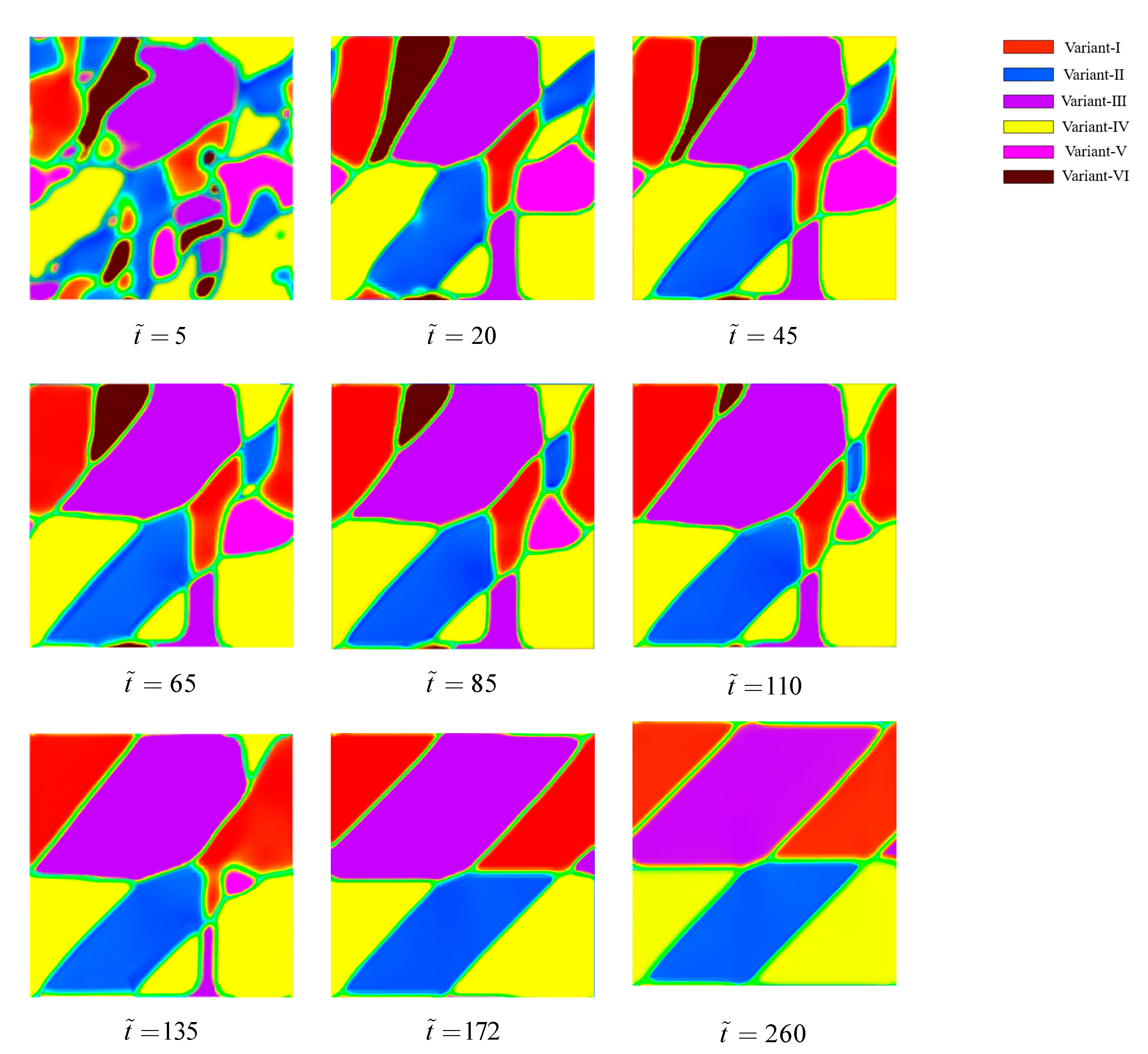
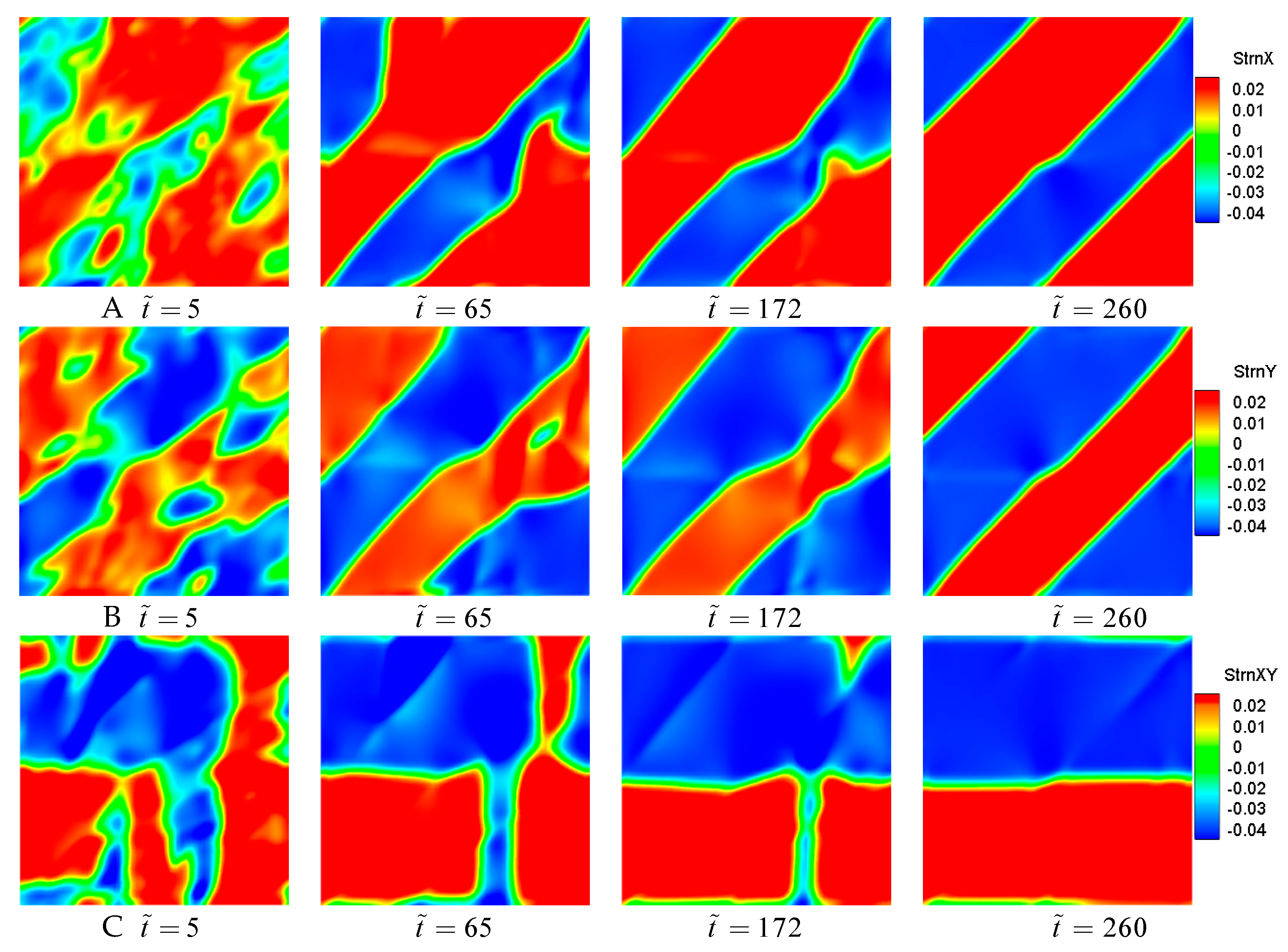
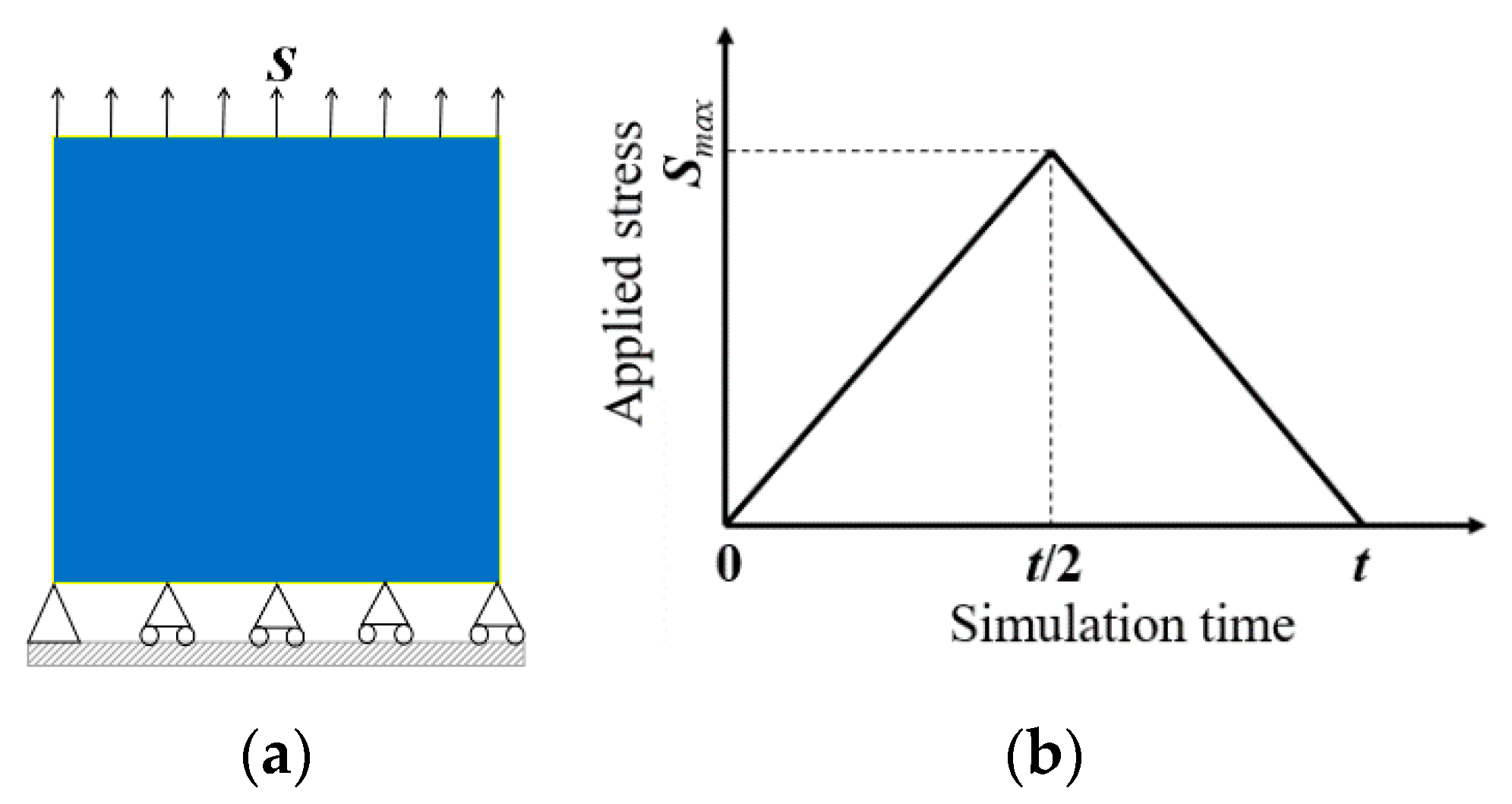
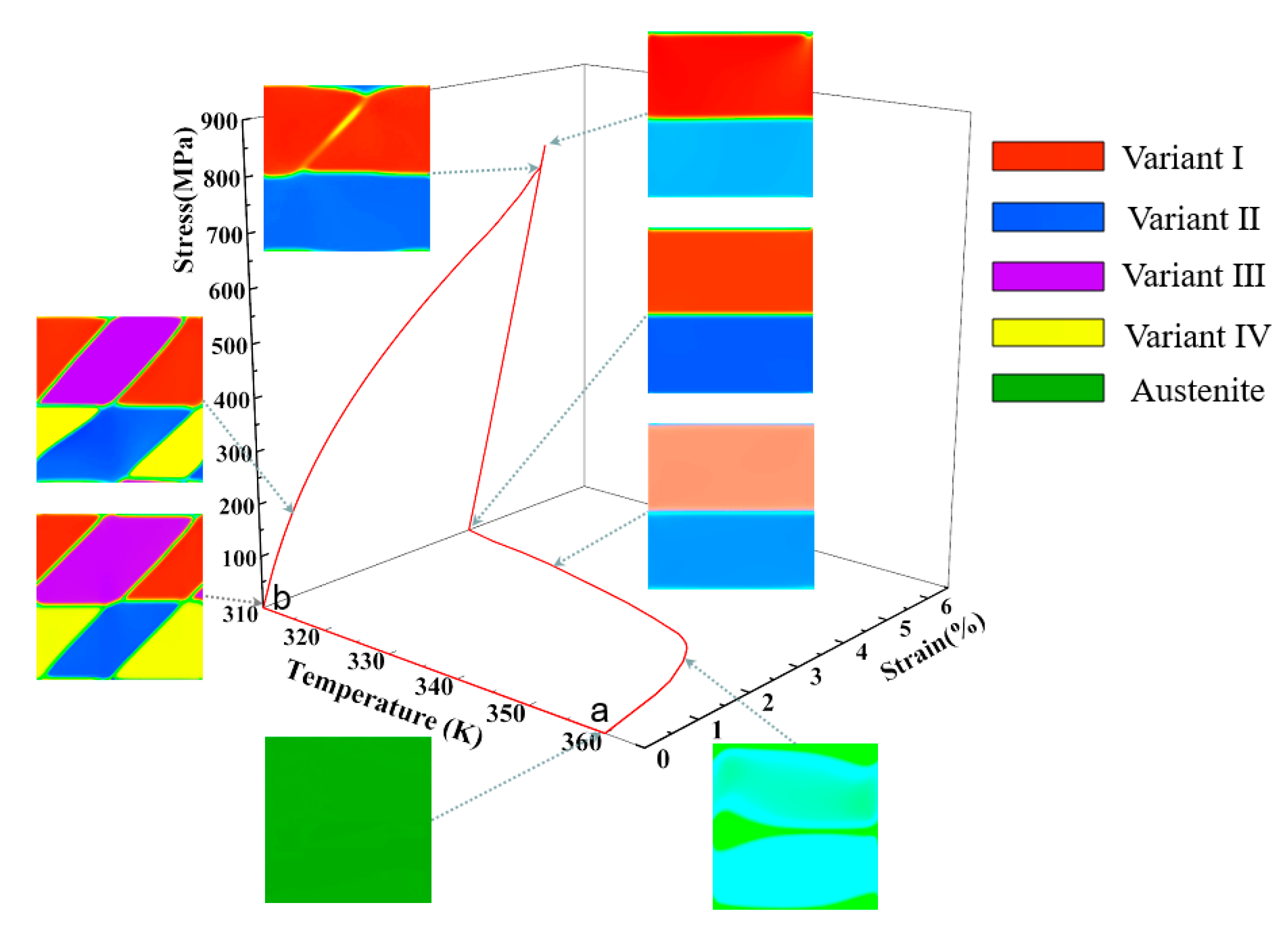
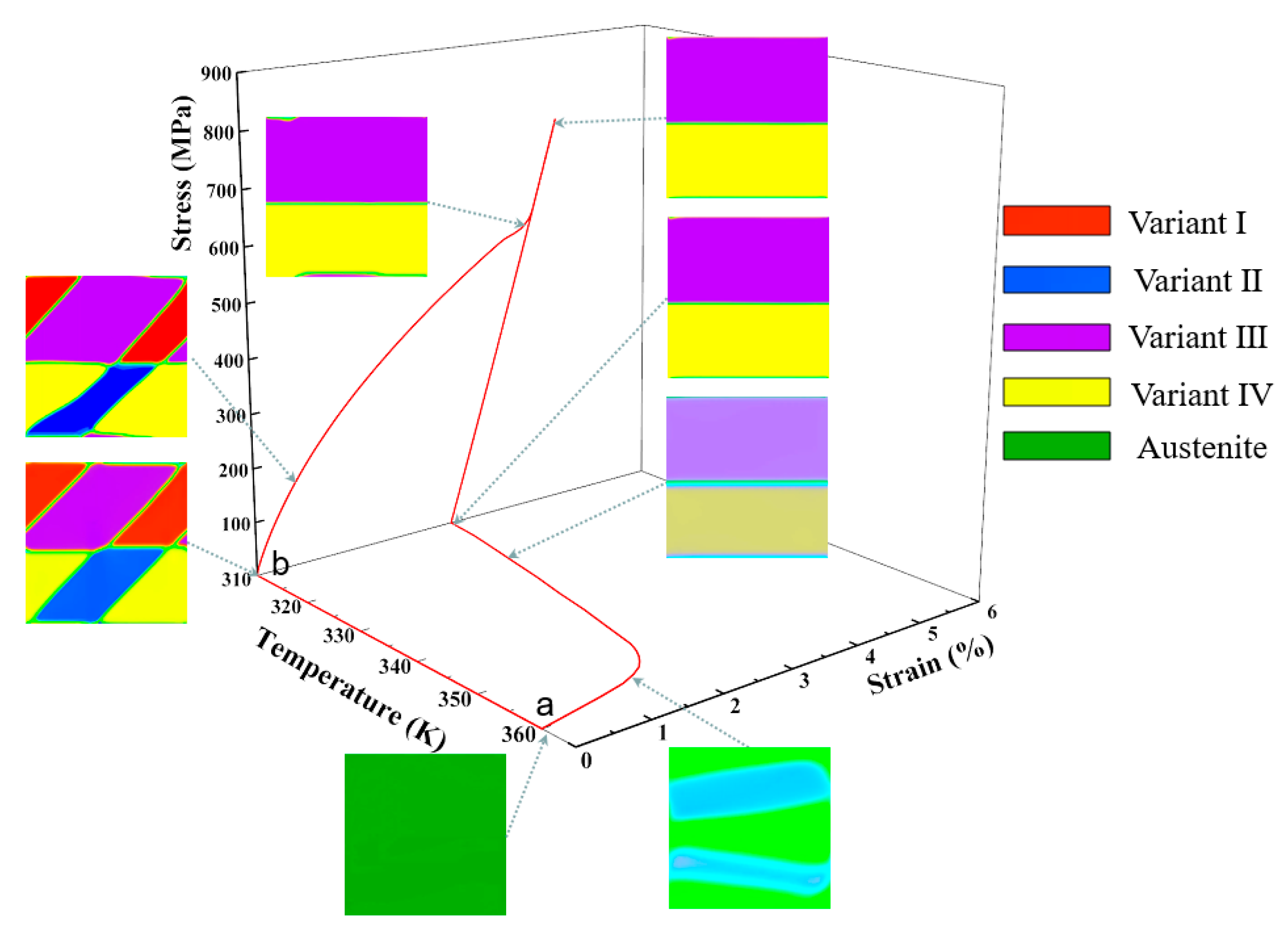
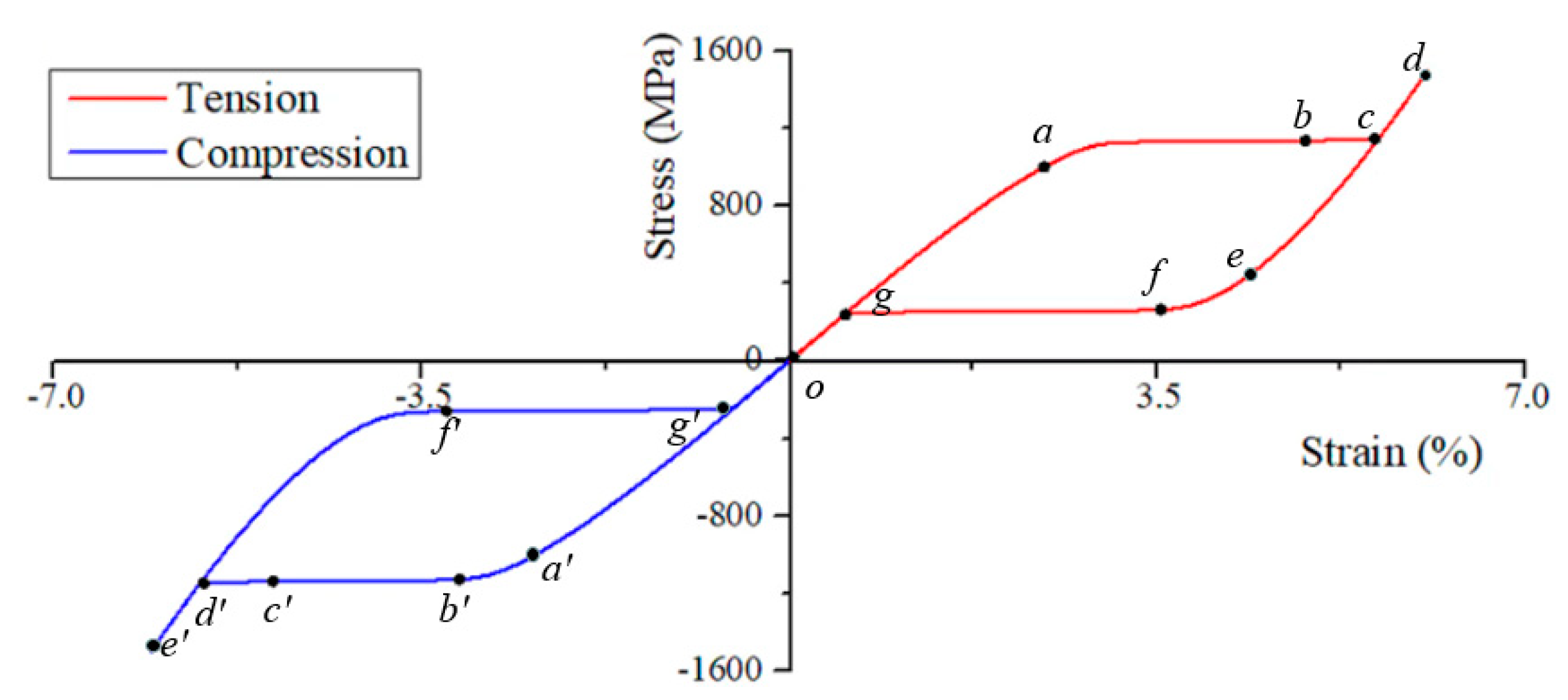
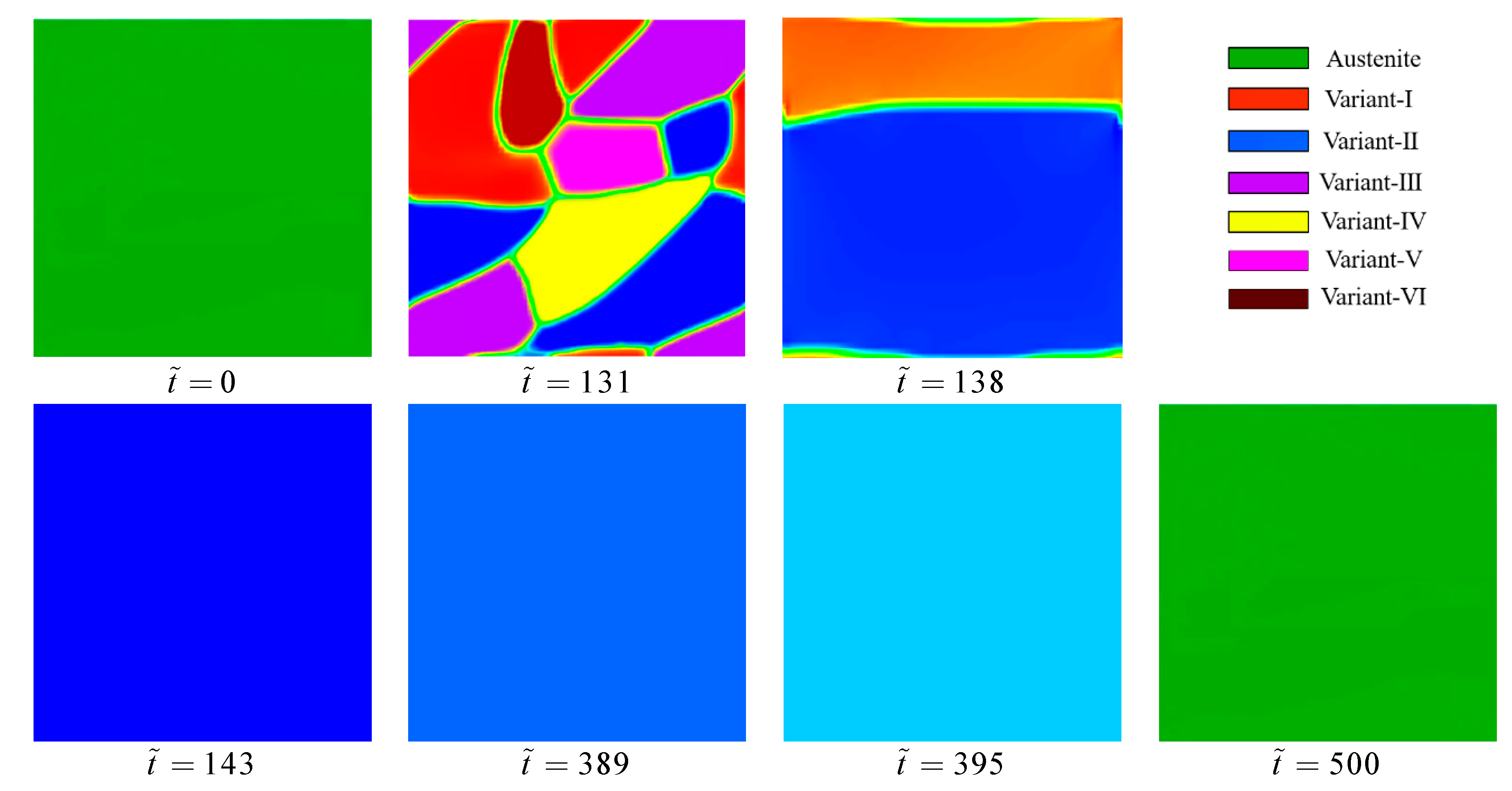

Publisher’s Note: MDPI stays neutral with regard to jurisdictional claims in published maps and institutional affiliations. |
© 2021 by the authors. Licensee MDPI, Basel, Switzerland. This article is an open access article distributed under the terms and conditions of the Creative Commons Attribution (CC BY) license (http://creativecommons.org/licenses/by/4.0/).
Share and Cite
Xi, S.; Su, Y. Phase Field Study of the Microstructural Dynamic Evolution and Mechanical Response of NiTi Shape Memory Alloy under Mechanical Loading. Materials 2021, 14, 183. https://doi.org/10.3390/ma14010183
Xi S, Su Y. Phase Field Study of the Microstructural Dynamic Evolution and Mechanical Response of NiTi Shape Memory Alloy under Mechanical Loading. Materials. 2021; 14(1):183. https://doi.org/10.3390/ma14010183
Chicago/Turabian StyleXi, Shangbin, and Yu Su. 2021. "Phase Field Study of the Microstructural Dynamic Evolution and Mechanical Response of NiTi Shape Memory Alloy under Mechanical Loading" Materials 14, no. 1: 183. https://doi.org/10.3390/ma14010183
APA StyleXi, S., & Su, Y. (2021). Phase Field Study of the Microstructural Dynamic Evolution and Mechanical Response of NiTi Shape Memory Alloy under Mechanical Loading. Materials, 14(1), 183. https://doi.org/10.3390/ma14010183




